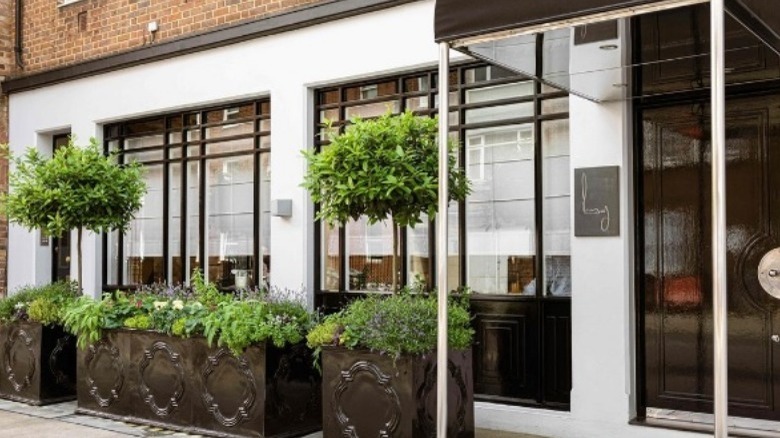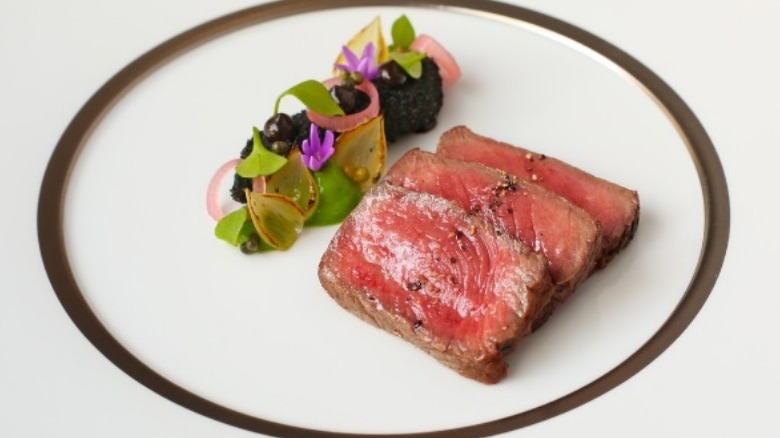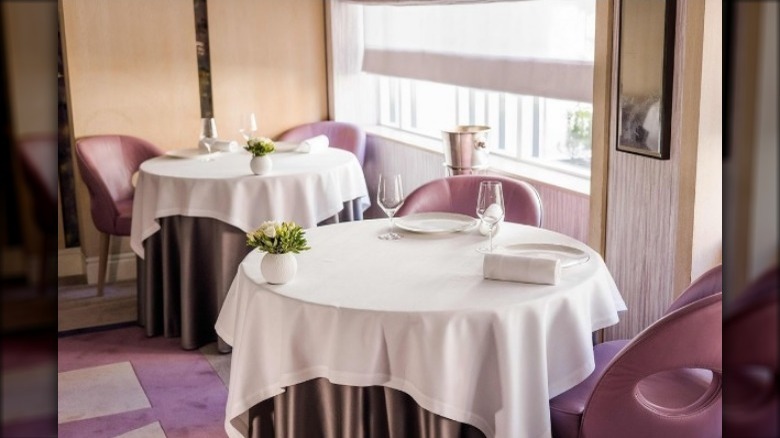I Ate At Gordon Ramsay's Flagship London Restaurant For The First Time And It Was Different Than I Expected
My husband and I knew that we couldn't miss dining at Gordon Ramsay's flagship restaurant on our trip to London. The world-renowned chef was only 31 when he opened its doors in 1998, and since then, it's gained three Michelin stars that put the food's excellence in perspective. Because of its limited dining space, sheer popularity, and celebrity owner, we had to book our table three months in advance.
Small and unassuming, Restaurant Gordon Ramsay is the perfect example of "blink and you might miss it." The façade is nothing special — just a white building with a black door and window, only identifiable by an easy-to-miss rectangular sign. After you finally decide you're in the right place, a doorman confirms your reservation before leading you inside. You notice within the first few glances that the dining room mirrors the exterior in simplicity, but something about this adds to the charm, making you feel more comfortable like you "fit" no matter who you are. To paint a picture of its intimacy, the restaurant only seats 45 people.
This immediate impression was the first thing that rearranged my expectations, though not in a bad way — I was just surprised that the restaurant's larger-than-life reputation didn't lead to a flashier presence. It's also specifically structured; you won't see an extensive menu but rather a few choices that keep the process simple.
Guests can choose from a handful of dining experiences
Restaurant Gordon Ramsay offers a handful of options to shape your dining experience, but even so, the menu is minimalistic. For me, this eased the stress of making the "right" choices. Guests can order from the menu prestige, which delivers a showcase of some of the best items, or a carte blanche menu that puts all the decisions in the hands of Chef Patron Matt Abe. Those seeking the ultimate experience can book the Inspiration Table, which focuses on modern, creative dishes. Once again adding to the list of unexpected, I was bewildered by the dining possibilities.
I chose the go the a la carte route, allowing me to choose a starter, main course, and dessert. Each section had four alternatives, in which I chose scallops from the Isle of Skye, 100-day aged Cumbrian blue grey, and a raspberry soufflé. Admittedly, I had no idea what a Cumbrian blue grey was until I sneakingly Googled it (spoiler alert: it's steak). I felt this way about a few items, so I wish the menu provided further information explaining what everything is for us 20-somethings.
A few things definitely stuck out to me when indulging in my personal selections. Beyond the unknown seasonings used for flavor, the scallops were especially memorable for their shellfish vinaigrette. But sadly, the steak was a bit chewy for my liking. Money willing, I'd like to try other options next time.
Unexpected offerings compensate for tiny portion sizes
While preparing for our trip, I spoke to many people who feel the price tag at certain Michelin-starred restaurants isn't worth the minuscule food portions. This concern prepared me for the possibility of dropping several hundred dollars just to leave and have food delivered to our hotel afterward. If you consider the a la carte menu at face value, this could ring true. My starter came with a mere three scallops, and my main dish was three sliced segments of beef with a baby-sized handful of vegetables.
One might wonder why a company making as much money as Restaurant Gordon Ramsay serves meals sized for the kid's menu. Unsurprisingly, the answer is in the question itself — to make even more money. Small rations lessen food waste and ensure diners get a full understanding of the flavors.
Shockingly, the small dishes turned out to be a nonissue. Throughout the meal, we were brought a slew of extra surprises, numerous palate cleansers, and a sizeable amount of bread. Truthfully, the honey-glazed bread might have been one of my favorite things I tried that night. We were also served a small dish of caviar decorated with peas. Unfortunately, this will likely be my first and final experience with caviar. My disdain was caused by what I felt was an unappetizing texture when the peas and fish eggs were mixed together.
For a small restaurant, employees were plentiful
In upscale environments, such as the one shaped by Restaurant Gordon Ramsay, service is just as important as food. According to research conducted by American Express, 72% of customers don't mind spending up to 16% more with companies that go above and beyond. In my judgment, this London-based restaurant passed the customer service test. Each employee we encountered was friendly and answered our questions, though some of our inquiries exposed our ignorance.
But friendliness and fast service weren't what made the restaurant interesting or unique — it was the distinctive techniques that took care of that. Whereas most eateries operate with one server per table, employees at Restaurant Gordon Ramsay deliver a presumably prearranged service to each table. Along with what I'd deem our "head server," there was someone who delivered and refilled wine, another who brought us our hors d'oeuvres, and one who carried food out of the kitchen, but stopped short of the table to pass it to the "head server." This can prove a bit confusing if you don't know who to direct questions to, but the system seems to work, and anyone would undoubtedly be happy to help.
As I reflect, I notice differences between how I pictured the experience and how it unfolded. I wasn't prepared for the comfortable atmosphere, the abundance of employees, or even feeling full when I left. This positively redefined my image of fine dining, maybe even too much as I continue my culinary travels.



